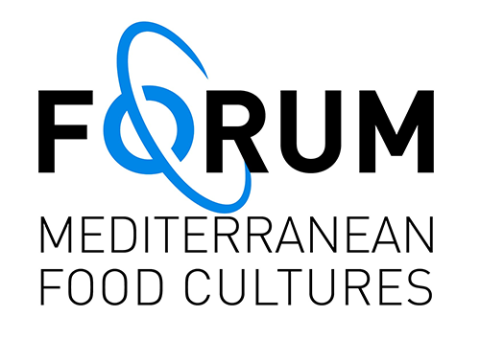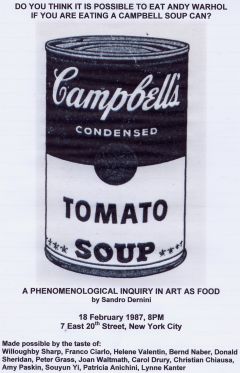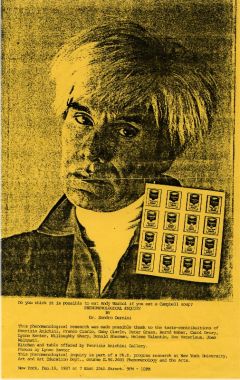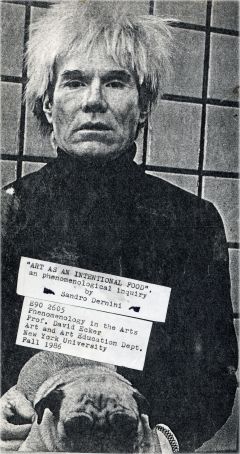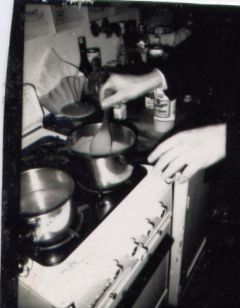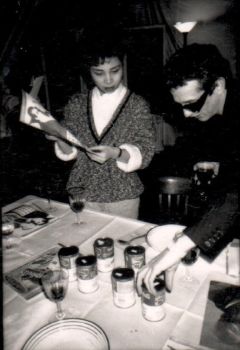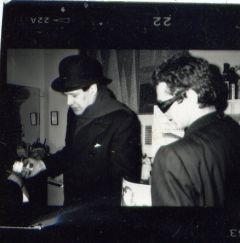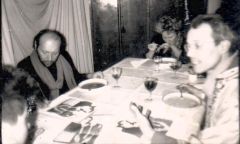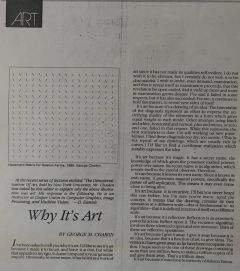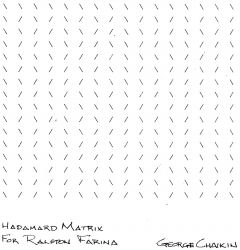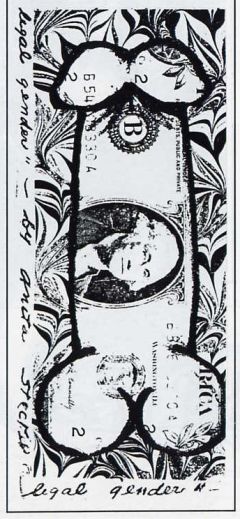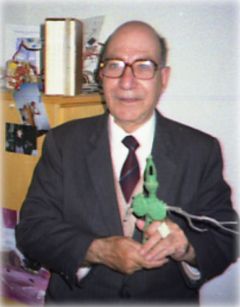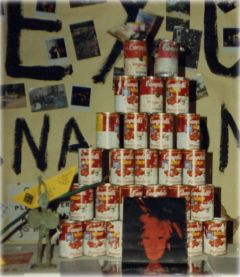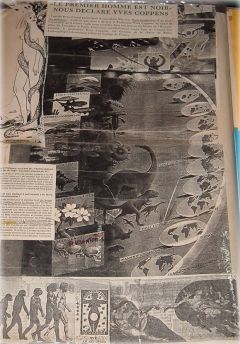On 18 February 1987, in New York, at the Patrizia Anichini Gallery, I RITUALLY performed
DO YOU THINK THAT IT IS POSSIBLE TO EAT ANDY WARHOL BY EATING A PLEXUS CAMPBOLL'S SOUP CAN?
as an aesthetic inquiry for my PhD course E90.2605 on Phenomenology and the Arts at New York University, directed by prof. David W. Ecker, to achieve a basic knowledge of the literature of phenomenological aesthetics and skills in phenomenological inquiry in the arts.
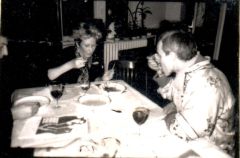

Invited artists were Willoughby Sharp, Helen Valentin, Bernd Naber, Franco Ciarlo, Donald Sheridan, Peter Grass, Lynne Kanter, Souyun Yi, Carol Drury, Amy Paskin, Christian Chiansa, and the host Patrizia Anichini.
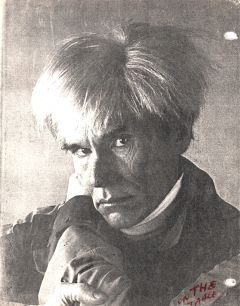
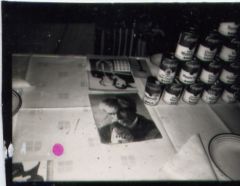
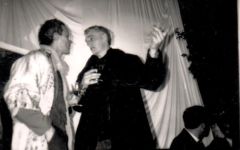




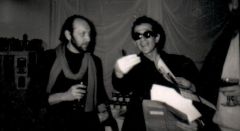
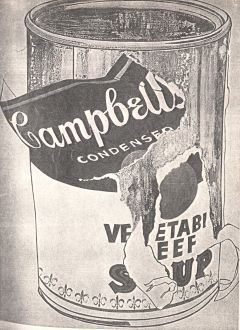
I prepared a questionnaire to be filled by participant artists after having cooked and eaten a Campbell's soup can. Seven questions I posed in the questionnaire, conceived for my phenomenological performance upon my NYU PhD course on Phenomenology and the Arts and my PhD reaserch study on "ART AS FOOD".
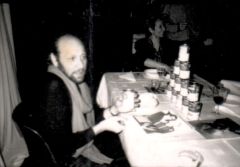
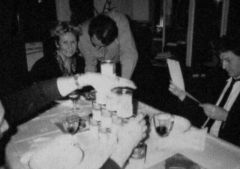
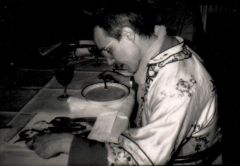
QUESTIONNAIRE
Do you think it is possible that you have eaten Andy Warhol when before you ate that Campbell soup two minutes ago?
- Suspend your belief before to answer to these questions. Answer: yes or no?
- What you mean?
- How do you know?
- How was the taste?
- Is it true or not?
-
Who was the subject? Who was the object?
- Description of the experience


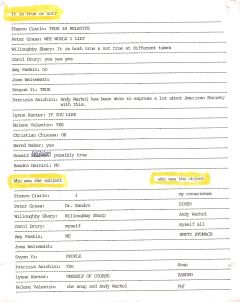
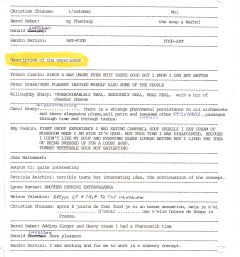


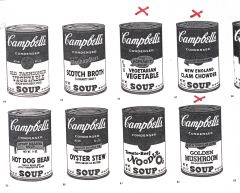
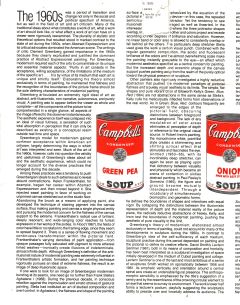
From the artist answers to the questionnaire, the majority of believed they “ate” Andy Warhol dematerialized.
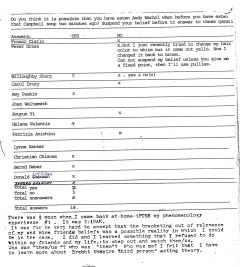
WERE WE CANNIBALS?
I prepared my phenomenological performance, by being inspired for moving forward my NYU Ph.D inquiry on "ART AS FOOD", by the symposium The Dematerialization of Art, organized the day after at New York University by Angiola Churchill and Jorge Glusberg, co-directors of ICASA (International Center for Advanced Studies in Art), where I was working as a graduate assistant of prof. Churchill, chair of the NYU Art and Art Education Dept.
"Heisenberg's Uncertainty Principle of 1907 with its recognition that the behaviour of the atom could not be predicted proposed a new reality that the artist has only begun to grapple with. What is the status of art if a discernible reality no longer exists?
Advanced technology has vastly expanded the human sensorium. What results from this increase of information largely depends on the interpretative abilities of the artist.
Scientific breakthroughs have presented not just a new version of reality but also of time and space.
What significance this will have for art cannot yet be said but we are clearly on the brink of the most extraordinary leap in human perception".
(From the brochure of the Symposium on The Dematerialization of Art, International Center for Advanced Studies in Art, New York University, 1987)
Few nights after, on 22 February, Andy Warhol died!

At the opening of the Symposium, Lenny Horowitz and Stephen Di Lauro, two Plexus historical players, by reporting from the floor the Sandro's performance, questioned the panelist about this potential dematerialization of Andy Warhol into a Campbell's soup can.
NYU, ICASA SYMPOSIUM TISCH AUDITORIUM, FEBRUARY 1987
“A Question to the Symposium on the Dematerialization of Art”
Art has its roots in ritual. We have only to look at the works of early shamans drawn on the walls of caves at Altamira and Lascaux. In addressing the idea of the dematerialization of art, aren’t we really taking about ritualistic art which cannot be repeated or preserved, setting aside for a moment the question of documentation, which is really a tool for raising capital. Take it a step further: the dematerialization of art is really ritual for the sake of ritual. Last night Sandro Dernini asked if when eating Campbell’s Soup, we are eating Andy Warhol—spoofing, if you will, the Christian communion ritual. This idea of concept of dematerialization as ritual is even further underscored in a performance, say, where 13 people gather to eat Campbell’s Soup. The soup has dematerialized into the stomachs of the participants and the gestures and words of those gathered have dematerialized into the air, not to be repeated again word for word, slurp for slurp. So the ritual dematerializes as it takes place. Dance, theatre—these stem from a need to ritualize, or make repeatable, certain words, movements, gestures. Another example, even more appropriate to the point I’m making raising this question with the panel, is the Plexus Art Operas, where hundreds of artists gather together to perform a theme. Dance, theatre, musical performance and visual arts are all combined here with the central idea of a modern sacrifice – sacrifice being an art ritual, of course. Bur the modern sacrifice of sacrifice, the end of ritual, really. So in talking about the dematerialization of art, aren’t we really talking about the demystification of ritual, the end of ritual. The impulse to include the audience, as in the happenings and the Living Theatre, is really the impulse of make shamans of us all, audience and artists alike. So, do you or do you not agree that the dematerialization of art is really art for the sake of demystifying, or even doing away with ritual, by making art? Whose Serpent? Who is the Serpent? Stephen DiLauro
Nam June Paik, among the speakers, answered believed possible that Andy Warhol had been dematerialized through the artist intentional act of eating his commodity art symbol.
The panelists were Jean Baudrillard, Donald Kuspit, Vito Acconci, Nam June Paik, Judy Barry, Dennis Oppenheim, Billy Kluver, Nancy Holt, Paul Taylor, Bruce Breland, Flor Bex, Rene Berger, Eika Billeter, Alan Bowness, Julie Lawson, Hervè Fischer and George Chaikin.
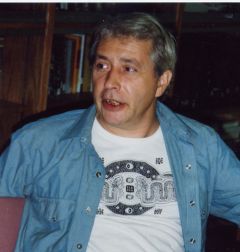
Hadamard Matrix Why it is Art
by George Chaikin, 1987
The Dematerialization of Art Symposium, ICASA International Advanced Studies in Art, New York University 1987
I’ve been asked to tell you why it’s art. I’d like to say it’s art because I made it to be art, and leave it at that, but while that appeals to my ego, it doesn’t respond to your genuine inquiry. Obviously, in some sense, it has failed as a work of art since it has not made its qualities self-evident. I do not wish it to be obvious, but I certainly do not wish it to be obscurantist. I wish to invite, even demand, examination, and that it reveals itself as examination proceeds, that this revelation be open ended, that it yield up more and more as examination grows deeper. I’ve said it failed in some respects, but it has also succeeded. For me, it continues to hold fascination, to reveal new sides of itself.
It’s art because it’s a drawing of an idea. The bimodality of the diagonals represents an effort to express the underlying duality of the elements in a form which gives equal weight to each mode. Other attempts using black and white, horizontal and vertical, plus and minus, or zero and one, failed in this respect. While this represents the best realization to date. I’m still working on new possibilities. I find these diagonals too dry, too ascetic. (This is not typical of my drawings, which are usually rich in curves.) I’d like to find a curvilinear realization which suitably expresses the idea.
It’s art because it’s magic. It has a secret name, the knowledge of which gives the possessor exalted powers, power over nature. Its secret name is its algorithm, which reveals itself to be careful observer. Therefore…
it’s art because it knows its own name.. Since it knows its own name, it possesses magical powers, specifically the power of self-replication. This means it may even come close to being alive.
It’s art because it is recursive. I’ll bet you never heard this one before, but I’m sure you’ve encountered the concept. It means that drawing contains its own reiteration at a different scale – this is fundamental to its algorithm – that it is defined in terms of itself on a different scale.
It’s art because it’s reflective. Reflection is an extremely powerful action. Reflect upon it. The recursive algorithm involves three identical copies and one inversion. Both of these are reflective operations.
It’s art because I give it away. I give it away because it is anidea, because yjay’s function of art, ti give ideas. The versions I have giving away so far been too sparse, too thin. I hope soon to do of these drawings containing more that one million lines, to make a million copies of it and give them away. That’s a trillion lines.
It’s art because it was done in memory of Ralston Farina
THE PLEXUS CIRVILINEAR GEOMETRY OF CONSCIOUNESS
The Andy’s dematerialization performance, then, became a Plexus controversial event for promoting the upcoming Serpent art co-opera in Sardinia.
In 1986, at the Plexus Art Opera n.3 "EVE- Escaping from Anno Domini" on board an art slaves ship, hundreds George's Hadamard Matrix copies were given away by Stephen DiLauro, acting as Lorenzo de' Medici, throughing them out the,m together with copies of the penis legal gender dollar by Anita Steckel while artists were sold in auctions were bought by the Royal ArtWorld Family.
Storyline Plexus Art Opera n.3 "Eve, Escaping from Anno Domini on board of an Art Slaves Ship" 1986, NYC
Plexus Art Opera "EVE" was a collaborative avante garde opera, a modern sacrifice. This one night extravaganza was a compression of time, space, relativity, recreating archytypes and modernizing mythology. It had it's root in experimental total theatre and happenings. It place on a mythological art slave ship and was performed by more than 200 contemporary artists handcuffed together.

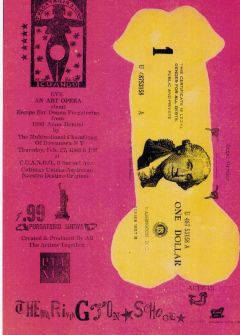
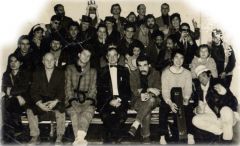

It was a metaphoric opera all about Eve in her escape in the divine comedy from the written history of Anno Domini.The EVE journey started on board a metaphoric art slave with notions about what is comic and what is divine -- Mythology was the wind in the sails of the art slave shuttle ship, mythography was the route through the Downtown New York Purgatory Chain Gang Culture to the Apple New York City Art World with the artists auctioned with penis dollars used to buy them.
My Eating Andy Warhol phenomenological inquiry performance for prof. Ecker was my second one. My first inquiry performance was Eating Art: A Refracted Self-Portrait, conceived for my NYU paper on “Art as Food” for the PhD course E90.2605 on Phenomenology and the Arts at New York University, by prof. David W. Ecker, that I staged on 25 October 1986, at Fusion Art space of Shalom Newman, in Stanton Street.
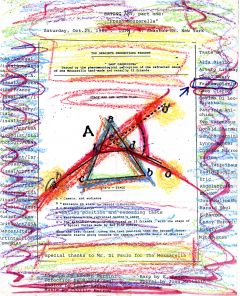
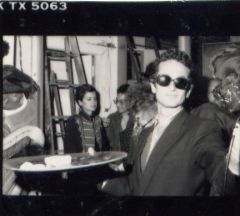
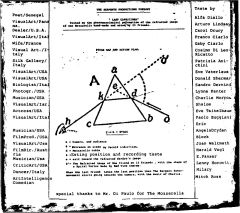

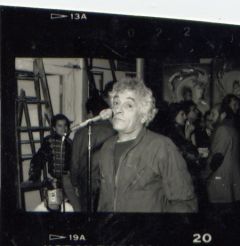

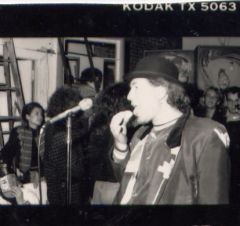
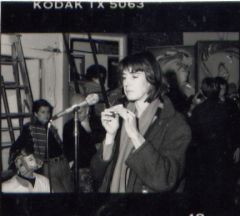
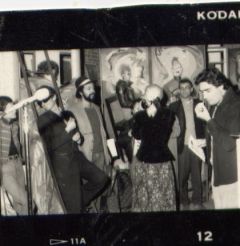
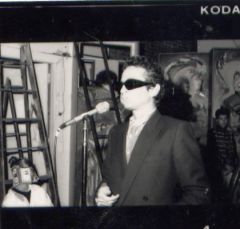
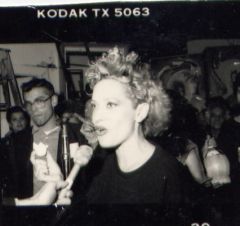
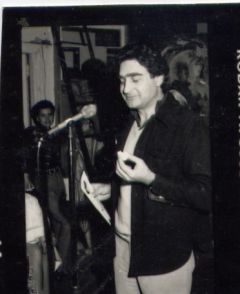
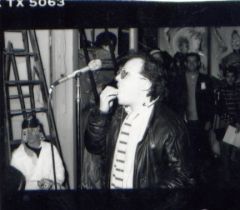

I invited 23 artists, many of them who also then participated to the 1987 Eating Andy Warhol performance: Eve Vaterlaus, Joan Waltmath, Arturo Lindsay, Franco Ciarlo, Paolo Buggiani, Lenny Horowitz, Lynn Kanter, Cosimo Di Leo-Ricatto, Slalom Newman, Charlie Morrow, Eve Taitelbaun, Angela Dryden, Carol Drury, Donald Sherman, Patrizia Anichini, Gaby Ciarlo, Mitch Ross, Alfa Diallo, Eric, Hilary, Herald Vogl, Block, E. Panzer, to eat a “bocconcino” mozzarella piece hand-made by an Italian living traditional master, Mr. Di Paulo, in Little Italy.

One after the other one, they expressed on a mic their individual taste, while be photographed by Lynne Kanter.
Then, all 23 photos by Lynne were displayed on a billboard together with a Sandro’s photo portrait and a comic portrait of me made by Mitch Ross, following a optical refraction diagram through which my overall identity could be phenomenologically perceived as refracted by my cultural social context.
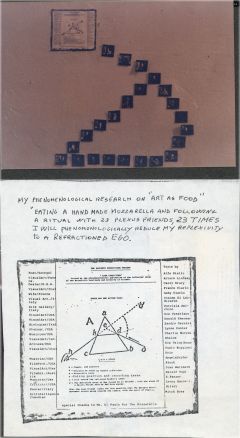
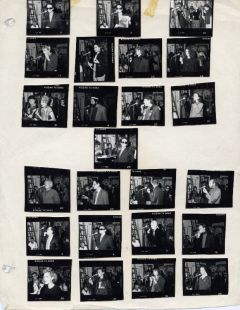
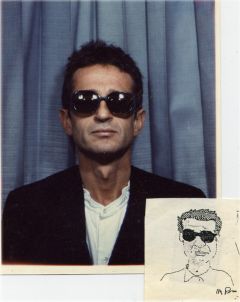
As ending act, in a collective serpentine movement, I gave out to the audience the Serpent Open Call as an invitation to participate in Sardinia, in the summer 1987 to the Plexus event that I was organizing as a co-authorship art venture.

Let me introduce myself in the first person,
I am Plexus 23s , aka Dr. Sandro Dernini

I have a double identity, I am a Plexus artist, as well as, I am a scientist.

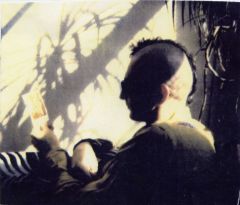

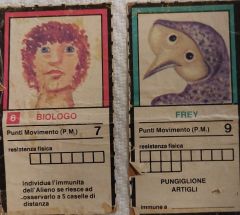
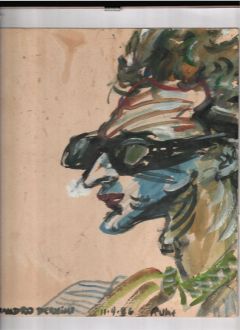

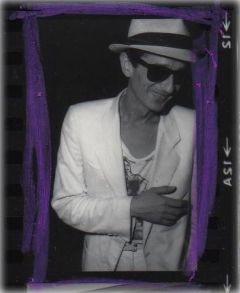
As a scientist, in 1974, I got my university degree (laurea) in Biological Science, at the University of Cagliari (Sardinia), and in 1997, I got my Ph.D. in Art Education, at the New York University.
Since early 90’s, I started to foster an enduring transdisciplinary dialogue among international scholars from different fields, connecting the well-being to the Mediterranean diet, sustainable diets and food sustainability. I published many peer reviewed scientific articles, books, and organized many international conferences and projects with United Nations and Intergovermental Organizations, including three World Conferences on the Revitalization of the Mediterranean Diets, in 2016 in Milan, in 2019 in Palermo, and in 2022 in Bari.
I have also a double cultural identity: I am “Sardo” (from Sardinian) and Italian. My nationality is Italian but my culture is "Nuragic", the bronze age civilization of Sardinia.
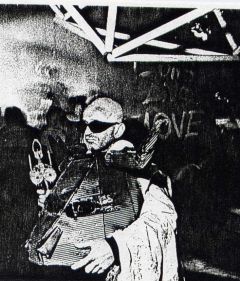
I discovered my Nuragic identity, in August 1984, in a burned building, at 523 East 6th Street, in the Lower East Side, where I was living, when prof. Raimondo De Muro, an old Sardinian friend of my family, knocked to my door, in the second floor with ruined stairs to go up to ask. He told me about the ancient oral tales of the Nuragic people of Sardinia, that did not known. He showed some ancient images of bronze statuettes of nuraghic warriors, with four arms, four eyes and two antennas and he spoke about some oral tales reporting how his Nuraghic ancestors were able to travel in a “dematerialised” way, from one place to another one, through collective rites.

In the island of Sardinia from 1500 B.C. to 800 B.C. there was a bronze age civilization, called Nuraghic. It was a very complex social society which built a system of 17.000 stone towers on the
Prof. Demuro asked me to support him to find in New York a publisher for his book "I Racconti della Nuraghelogia". I was totally fascinated by his speaking on my forgotten Nuragic Sardinian heritage. Then, I introduced him to Stephen DiLauro, a playwriter living next door, and frequent at the Shuttle Theatre in my basement building. I knew that Stephen was very attracted by Robert Graves' White Goddess and by mysteries of the ancient world.
 Stephen liked it and wrote an introduction to the English De Muro's book synopsis, entitled “The Towers of Power”, about synchronicity, UFOs, and “cosmic net”, questioning if thousand stone towers of varying heights exit, as the remains of a bigger ancient network could be the center of an interplanetary communication network of a universal memory.
Stephen liked it and wrote an introduction to the English De Muro's book synopsis, entitled “The Towers of Power”, about synchronicity, UFOs, and “cosmic net”, questioning if thousand stone towers of varying heights exit, as the remains of a bigger ancient network could be the center of an interplanetary communication network of a universal memory.
NEW BOOK UNLOCKS SECRETS OF ANCIENT ARCHITECTURE
TOWERS OF POWERS Tales of the Nuraghic People of Sardinia by Raimondo De Muro
Introduction by Stephen DiLauro, alias E. Kishmet, 1984, New York
On the Mediterranean Island of Sardinia some seven thousand stone towers of varying heights exit as the remains of a network that originally consisted of seventeen thousands of these structures. Who built them? What was the purpose to this vast undertaking? Is it possible that this was the center of an interplanetary communication network?
Professor Raimondo De Muro, in his best-selling book (over 30.000 copies sold in the Italian language Zephyr Edition) “Towers of Power: Tales of the Nuraghic People of Sardinia” reveals the key to secrets only hinted at in “Chariots of the Gods” and “Pyramid Power”. Professor Demuro, recipient of the Viareggio, the Marzotto, and the Grazia Deledda - Italy’s three most prestigious literary prizes - has chosen a unique manner in which to present this new and startling information. Using the techniques of both novelist and folklorist, he is able to entertain the reader while imparting facts that their very nature might otherwise see overly weighty.
Synchronicity, UFOs, the “cosmic net” that so fascinated the ancient philosophers - - these are but a portion of the material dealt with in Demuro’s writing. Is there a “universal memory” in all matter which mirrors the genetic memory of the higher orders? What is the significance of a recent discovery of over two hundred larger-than-life Bronze age statues depicting humanoid creatures with antennas in a Sardinia cave?
“Towers of Power” is not only startling for the new ground that is covers. It is also fresh and alive due to the craft and effort of one of the world’s leading expert of the mysteries of the ancient world.
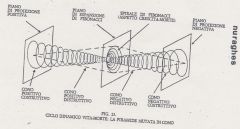
NURAGHES
DYNAMIC LIFE-DEATH CYCLE: THE PYRAMID TRANSFORMED INTO A CONE
On June 30, 1987, in Rome, at the Theatre in Trastevere, my old L.I.A.C.A. place, I organized a press conference with Willem Brugman, Miguel Algarin, Arturo Lindsay, Maggie Reilly, Shalom Neuman, Gianni Villella, Paolo Maltese, Carlo Cusatelli, Giovanna Ducrot, Armando Soldaini, followed by an happening recall LIACA parade in the Trastevere street, to present the Plexus art co-opera Il Serpente di Pietra, as the first international art slave market show in modern art history, with more 160 artists as art slaves coming from 23 different countries, that was going to happen in Sardinia, at the megalithic sanctuary of Sa Itria in Gavoi, from 1 to 4 July.
There, at the center of Sardinia, the first Art Slaves Market Show as Plexus Art Co-Opera n.4 "The Serpent of Stone", was staged as continuation of the Plexus Art Operan.3 "Eve, Escape for Donna Purgatatorio from Anno Domini", held in 1986 in New York as a metaphoric art slaves boat art journey escaping from the New York Art World control.


With more 160 artists as art slaves coming from 23 different countries, Il Serpente di Pietra was staged as four days of art and science, connected before internet existed to a scientists computer network by the Bruce Breland and Robert Dunn of the Dax Group of Carnegie Mellon and Franco Meloni of the University of Cagliari, as a multi-media fractal show dedicated to the Heinrich Hertz’s 100 years electromagnetic celebration for freedom in art communication.

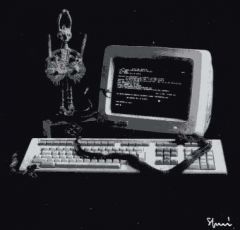
Photo Stefano Grassi
At the end, I performed the elimination of my image of artistic director of Plexus, expression of the pyramidal structure of the star system of the artworld, new contemporary form of slavery. Assane Mbaye invited all artists to go in 1988 to Dakar-Goree, as continuation of the Plexus art slaves voyage. As closing act Arturo Lindsay as the ancestral messenger set on fire a box containing all participants’ signatures.
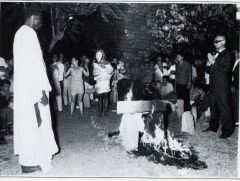
For me, behind personal conflicts and organizational problems and difficulties, the presence of so many artists coming from many different places, free to have an open and critic dialogue with their work of art, working at the same time-space on the same subject/object (the serpent), was a positive result to keep on the Plexus voyage in direction of Africa and to continue to explore the metaphor of universal myths, such as the Serpent, as a shuttle for a faster multi-lateral art communication.
After leaving Gavoi Sa Itria event, I went with Willem Brugman to Carloforte to carry my Nuraghic warrior on board of the Elisabeth boat with other records and relics from the Serpente di Pietra, to be placed next to the Don Cherry’s little Buddha, for the continuation of the Plexus art journey.

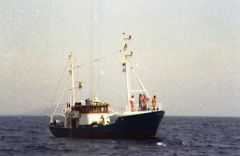

In the fall of 1987, thanks to the artworks by Gaetano Brundu, Antonello Dessi, Luigi Mazzarelli, Anna Saba, Gabriella Locci, Annamaria Caracciolo, donated in exchanged to the printer Franco Girina, an art collector, the art booklet "Passport for Plexus Serpent from Purgatorio to Paradise" , a 24 pages in English, Italian and French, was printed by Celt Editions, with me as editor, graphics by Gaetano Brundu and photos by Stefano Grassi, documenting the Serpent Plexus Art Co-Opera 4, held in Gavoi, Sardinia.
In the Passport for the Plexus Serpent, travelling from Puratorio to Paradise, I designed as big apple a Plexus strategy map, with inside a cultural navigation from my past art market graphics 1985-86. I placed an entrance/exit in Dakar, covered by the image of the Ningka Nangka serpent by Assane Mbaye, and I placed an other exit/entrance on the image of the Quetzocoatl plummed serpent by Richard Milone, a mythology as commodity symbol. Plexus coproduction structure, always in evolution, I represented as a truncate cone of a Nuraghic tower, built by the artist coproducers, associated together as in a modern rite.
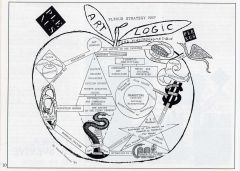
In the November 1987, while the traitional market collapsed, instead the art market had a very strong landmark sucess, for 53.9 million dollars it was sold the Van Gogh’s painting Irises, with a controversial, under the table, insider loan participation of the same auction house Sotheby to the buyer. Tis sale set a world record at that time for the highest price ever paid for a painting!!
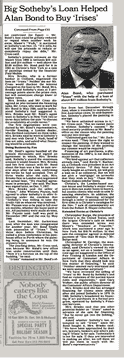
In the Plexus Serpent Passport, a six years Plexus plan, 1985-1990, was schematically divided by integrated phases of marketing mix: promotion, production, price, replacement, within short (1985-87), medium (1988), and long terms (1989-90), as a multilateral recall network, where recall meant collection of concept-images and memory for a co-authorship art venture, made by artists and scientists in the first person as co-partners.
In early December 1987, before to go to Dakar, I moved to Carloforte to perform my “dematerialized” Nuraghic ritual art love journey in direction of Goree. inspired by the oral tales of the old Nuraghic people, reported to me by Prof. Raimondo Demuro, who were able to travel, in a dematerialised way, from one place to another one, through collective ritual performances travelling through time and space. Influenced by it, I started to perform my nuraghic ritual actions as a modern sacrifice towards the continuation of my Plexus art journey to fly in direction of Dakar.
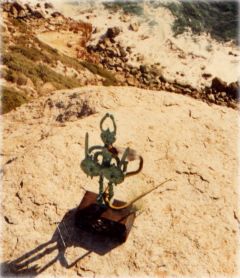
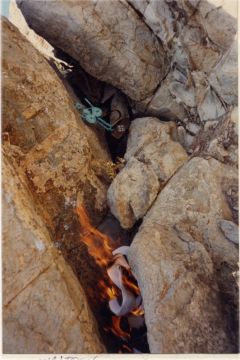
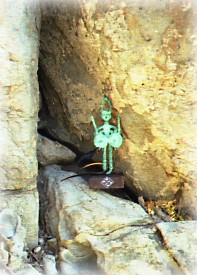
Few days after, I landed in the Medina of Dakar, at the house of the family of Assane and Kre MBaye, in rue 17 angle 8. Since then, I became very closed to all members of the MBaye family, managed by the two big sisters Awa and Marcel, with the help of Fatamata, Awa’s daughter. At Kre MBaye studio, I performed, with Langouste MBow, Kre, Assane, and other artists, the nuraghic ritual re-materialization of the Plexus Serpent Passport from Sardinia to the Medina of Dakar.
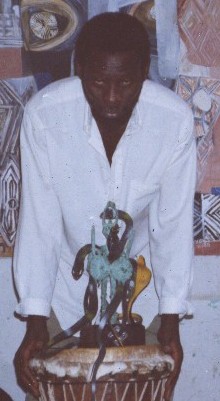
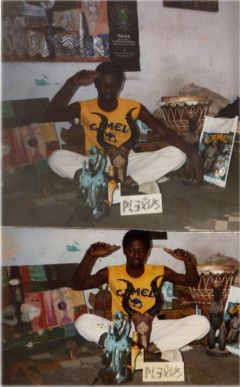
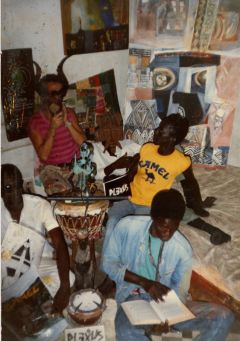
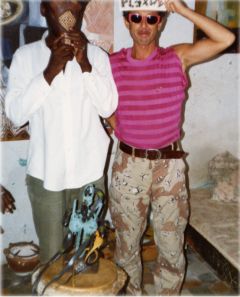
In New York, on February 20 of 1988, on the occasion of the first anniversary of my 1987 dematerialization performance of eating Andy Warhol, I ritually performed the Plexus happening “An Art Redefinition of a Campbell Soup Can”, in the dried swimming pool of CUANDO Cultural Civic Center, in the Lower East Side. I organized it as a Plexus report to the Lower East Side community, about developments of the Plexus journey of the art slaves boat, two years after its departure from the “Eve” art opera, its landing in 1987 in Sardinia and its planned arrival at the House of the Slaves of Goree, Dakar, in December 1988.
I staged it as a recall of my 1987 Andy Warhol ’s Dematerialized inquiry. this time I was inspired by a second ICASA symposium, The Redefinition of Art in the Collision of Cultures in the Post-Modern World, held in the same period at New York University by ICASA..
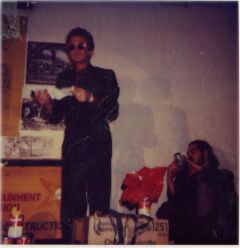
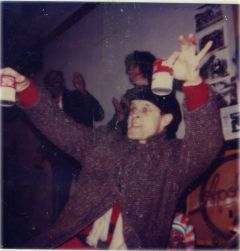
Barnaby Ruhe


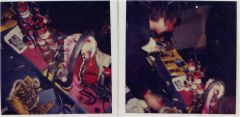
PLEXUS ART REDEFINITION OF A CAMPBELL SOUP CAN
In September 1988, for my birthday,with a party in a loft in Soho, I presented 100 Plexus Campboll's Soups Cans Labels, Made in the 80's for the 90's, as 100 Limited Editions, printed for me by Ram Studio of Maggie Reilly.

What does a PLEXUS Can look like?
It looks like an Andy Warhol's Campbell soup can, if it is exposed to a beholder of the artworld. Its label is red and white. The "e" of Campbell is changed to an "o" in Campboll's, It has a central circle with the words "Dematerialized Andy Warhol" and Andy Warhol's face which hold the center of attention. On its bottom the word PLEXUS.
It has a cylindrical form, balanced symmetrical design, a spatial organization with 2 red and white rectangular units, with written messages:
“DIRECTIONS: EATING ART and "INGREDIENTS : HISTORY OF MODERN ART, VOLUME 1- FOODART INTERNATIONAL".
Below Direction: Time Capsules Art. LTD 100 of 100. PLEXUS 23S Soup Sardinia Export. Printed in the USA
Below Ingredients: Ram Studio Inc - Designer R. Kern. New York, 5/88 AD.
The expectation as manipulation of mental imagery is a central referential step of the analysis. Changing "e" to "o" in the word Campboll’s prevents the Plexus Can being confused with a Warhol's can and with a simple Campbell’s can.
Both light and distance influence the reading of the outside codes of the object whether it is read as "e" or "o", whether you see or you do not see the glued-on penny painted as money art. The angle from which the object is viewed determines the perception of the object either as an original artwork by Plexus23s, or by Andy Warhol or a simple Campbell can.
Plexus Interpretation is not static. It is formed by the momentum of the rhythm of our experience and of its correlations. Each reader has his/her own angle of interpretation depending upon his/her personality, education, and culture. No method can transcend the interpreter's own historicity.
INGREDIENTS
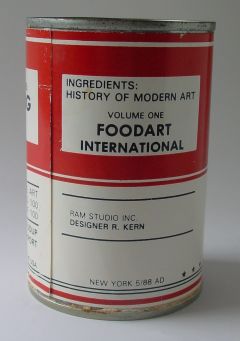
What does a Plexus Campboll’s Soup Can contain?
MY PHD NEW YORK UNIVERSITY AESTETIC INQUIRY INTO THE PLEXUS BLACK BOX
Sandro Dernini, Doctor of Philosophy, 1997
Major: Art Education, Department of Art and Art Professions
Title of Dissertation: A Multicultural Aesthetic Inquiry Into "Plexus Black Box,"
An International Community-Based Art Project.
Directed by: David W. Ecker
"Plexus Black Box" was a conscious act of recall of the struggle of the artists in the community, who are running ahead toward their own future. While the dissertation was about the past and is thus historical, it is also about the present and the future of Plexus.
"Plexus Black Box" materially consists of records and relics of Plexus history and performances. Many records consist of compiled images made as frames of reference or "quotes" of other records. Over the years Plexus events have built one upon the other. Each event takes place in its own present but it is made up of past concepts and activities while it projects its own various parts into the future activities of Plexus.
ABSTRACT
This study is a multicultural aesthetic inquiry into the "Plexus Black Box," a community-based international art project.
The collaborative art project under study, "Plexus Black Box," is related to a series of art events held in several communities around the world, beginning in 1982, engendering a spirit of cooperation and bridging the gap between universities and local communities.
The focus of Plexus is to raise the consciousness in the world community about the interdependencies of the arts, the well-being of individuals, and the reconciliation of cultural differences, through the extention and interaction of collaborative art events, bringing the community and the academy closer together, and linking the notion of "art" - as a culture-bound aesthetic experience - to the concept of "well being" - as a multicultural paradigm enhancing the quality of life in the community.
INGREDIENTS
HISTORY OF MODERN ART
VOLUME 1
FOODART INTERNATIONAL
FOODART is a High Electromagnetic Intentional Food by Plexus International
THE HISTORY OF PLEXUS 1982- 2024
In 1989, in Dakar, by ponting out the controversial case of the 53,9 million dollars for the Van Gogh's painting Irises, I presented the Plexus project for the opening of an Art World Bank in the House of the Slaves in the Goree island , created and managed directly by the artists in the first person, in order to survive and to resist to the economic-political control of the artworld of the Western market. As an example of the historic struggle of all artists in life, by recalling the poor economic life of Van Gogh, I underlined the need for all artists to survive and the value of art as a sustainable resource for the community. In this context, the House of the Slaves of Goree was for Plexus International the symbol of existing contemporary forms of slavery and the art trade market was part of it. I stressed that behind any work of art, traded as a commodity, there was a human being, the artist who needed to be defended by a new contract of art that he proposed to be negotiated and signed in Goree, as first milestone of the future Art World Bank that then in 1996 was launched formally by Plexus International on the occasion of a special event organized in Rome in the context of the first World Food Summit.

The content of a Plexus Campboll's Soup Can changes from one Can to another Can.
It depends upon the related circumstances under which a Plexus Can is made. What is inside this can is also an element of ambiguity of this art work.
What is inside this can is also an element of ambiguity of the work under study.
How will you open it?
The curiosity to open it, and the motivation to do it, will create the need of opener, as a method of reading, a system of intelligibility.
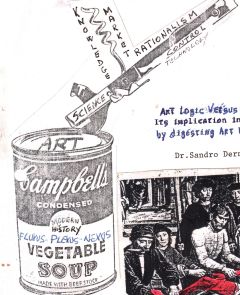
The expectation, the beholder's share, if the person is related to the art world, will transform an ordinary object, a Campbell Soup Can, into an artistic object, a PLEXUS Campboll’s Soup Can.
Plexus Can as an open work of art depends upon its community of beholders, formed by the momentum of the rhythm of that specific experience and of its correlations with my own in the first experience of this momentum.
Interpretations of clues are made by systems of intelligibility which are made by codes. Clues are supposed to be read as information. One of these clues is "Direction: -Eating Art". Another one is "Dematerialized Andy Warhol".
First question, how do we eat art, and if we eat art how do we digest it? Second question, how do we eat Andy Warhol dematerialized, and if we eat Andy Warhol how do we will digest him dematerialized?
Plexus Can functions within a ritual art performance environment depending upon the community of beholders, and their art references.
The Plexus Can, within its art altalr environment, is an intentional "bewildering image" of a work of contemporary art.
The expectation, the beholder's share is the keyplayer in the Plexus artistic process by transforming perception of PLEXUS Campboll's Soup Can into a historical contemporay artwork.
To start I applyed my 1988 NYU Course on Aethetic Inquiry, with David W. Ecker, for understanding art definitions, categories, styles, ArtWorld notion, and its exclusive priviledge of conferring the artistic identification, the status to be an "Artist".
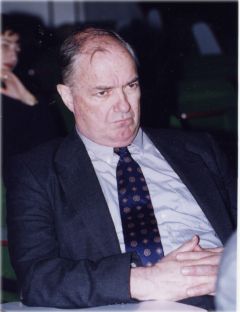
ART DEFINITIONS, CATEGORIES, AND ART MARKET:
NAMED IT "ART-SLAVER-ISM"
From the essay The Artworld by Arthur Danto: " to see something as art requires something the eye cannot decry-an atmosphere of artistic theory, a knowledge of the history of art: an artworld. Andy Warhol's Brillo boxes, because they were made by a person with an "artistic identification" belonging to an artworld, made
them "Art".
An artifact can acquire the status of a candidate for appreciation within the system that Danto has framed and explained as "The Art World".
For instance, Duchamp's "Fountain" is not just a misplaced urinal, as Arthur Danto wrote, " Once one accepts the possibility that a Brillo box by Warhol is a work of art, while an ordinary Brillo box is not, it is plain that the differences are not of a kind that meet the eye, and that the phenomenology of perception cannot be appealed to effect the differences, which are philosophical. The point is that Warhol's box acquires, in virtue of'being art, properties ontologically unavailable to its counterpart, and the problem of the philosophy of art is to explain not just how this is possible, but what the status of these properties is, in as much as the properties would not be present to the eye if you did not know you were looking at a work of art "
Each analysis of an art work has its own historical world related to a particular time and space.
What you will see, as virtual content of that specific Plexus Campboll's Soup Can Limited Editions, is an artists time-space, a PLEXUS place, dissociated from current mundane art world environment under market control.

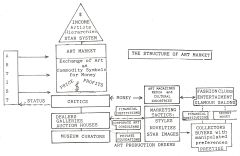
DIRECTIONS
EATING ART
ART IS A BIOLOGICAL NEED FOR OUR EVOLUTION

In the Evolution of the Homo Sapiens corpus, Biology and Culture are interconnected by the genetic capacity to modify, convert, and transmit metabolic ionic charges as cultural messages.
Many factors of Culture and Biology are crossing over as part of a whole socio-biological organism, in which also the individual body and mind are genetically interacting together and in interdependence.
The human being is made by an integrated system of body and mind, a sociobiological organism absorbing and transforming “energy”, which provides necessary ionic charges for it sociobiochemical moves.
These ionic charges effect the recombination of many conductive chemicals in solution in the human body, during the physiological process of transformation from “Matter-Food” into “Energy”.
The ionic recombination supply the recycling “Energy” for the human body to exist and to think.
Through networks of differentiated cells in communication together by interactive systems (Plexus or Charas) this “Energy” is responsible of the sociobiological information and its genetic transmission.

The human being like the physical world, with all its animate and inanimate realities, is made in space and time, by ionic transformations of differentiated states of “Energy” as “Matter”.
In both the human and the physical world diversity in forms and behaviors is only a phenomenological effect of the atomic crystal configuration on which the micro and macro realm of the Reality is build.
The whole Reality in which the human being lives is time-factored by energy configurations and transformations of the ionic crystal mask of “Matter” from the computer silicon chips to the physiological sodium pump of the human cellular membranes, from the snow to the rocks of the mountains, from the DNA of the chromosome to the bones of the skeleton, from thinking to conversation.
The solar PLEXUS is a complex of PLEXUS, CHAKRAS, connecting billions and billions of individuals cells as a whole living organism, the human being, able of reproduction, of growing, of modifications of thinking, and transmitting culture.

